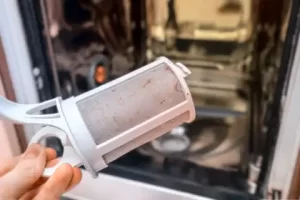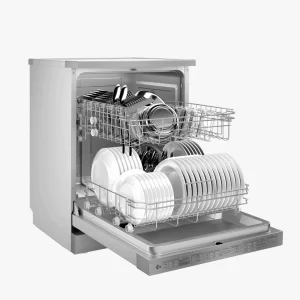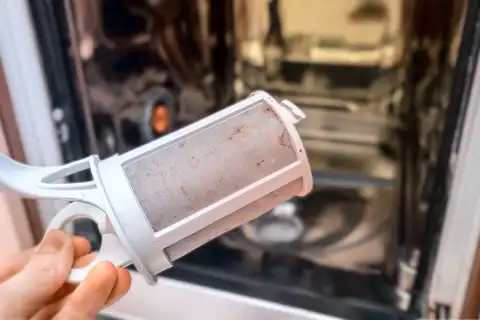If you own a Whirlpool dishwasher, you’re likely familiar with the convenience it brings to your kitchen. These appliances are designed to make your life easier by handling the dirty work of washing your dishes. However, to ensure your dishwasher continues to function effectively, it’s essential to keep it well-maintained, and that includes regularly cleaning the filter.
In this article, we’ll walk you through the process of cleaning the filter in your Whirlpool dishwasher, so you can keep your dishes sparkling clean.
Why you should clean the filter in a whirlpool dishwasher?

The filter in your dishwasher plays a crucial role in the cleaning process. It traps food particles, debris, and other contaminants, preventing them from clogging the dishwasher’s spray arms and water pump. A clogged filter can lead to poor cleaning performance, unpleasant odors, and even damage to your dishwasher.
Before cleaning the filter in a whirlpool dishwasher, ensure you have the following items ready:
Prioritize Safety:
Take the precaution of turning off your dishwasher and disconnecting it from the power source to prevent any potential accidents.
Protective Gloves:
Consider wearing rubber gloves as a sensible measure to shield your hands during the cleaning procedure.
Screwdriver (if necessary):
Depending on the specific model of your dishwasher, you might require a screwdriver to gain access to the filter.
Step-by-step Guide on How to Clean Mold Out of Dishwasher
Steps to Clean the Filter
Now, let’s get started with the clean the filter in a whirlpool dishwasher process:
Remove the Bottom Rack:
Open your dishwasher and slide out the bottom rack. Set it aside to give you better access to the filter.
Locate the Filter:
The filter is typically found at the bottom of your dishwasher. It may be circular or rectangular, depending on your dishwasher model.
Remove the Filter:
Depending on your dishwasher model, you may need to twist or unsnap the filter to remove it. If there are any screws securing the filter in place, use a screwdriver to remove them. Be gentle to avoid damaging the filter or dishwasher components.
Clean the filter in a whirlpool dishwasher:
Once you’ve removed the filter, rinse it under warm running water to remove any loose debris. Use a soft brush, an old toothbrush, or a sponge to scrub away stubborn food particles and residue. Pay special attention to the mesh or screen part of the filter, as this is where most debris accumulate.
Soak in Vinegar (Optional):
For thorough clean the filter in a whirlpool dishwasher, you can soak the filter in a solution of equal parts water and white vinegar for about 15-20 minutes. This helps break down mineral deposits and removes any lingering odors.
Rinse and Dry:
After cleaning the filter in a whirlpool dishwasher or soaking, thoroughly rinse the filter with clean water to remove any vinegar residue. Allow it to air dry completely before reinstalling it.
Reinstall the Filter:
Carefully place the clean and dry filter back into its original position. Ensure its properly secured.
Replace the Bottom Rack:
Reinsert the lower rack into the dishwasher.
Turn On the Dishwasher:
Once the filter is back in place, turn on the dishwasher and run a short cycle to make sure everything is functioning correctly.
How to Load Silverware in a Dishwasher?
Regular Maintenance

To keep your Whirlpool dishwasher running smoothly, it’s a good practice to clean the filter in a whirlpool dishwasher at least once a month, or more often if you notice a decrease in cleaning performance. Additionally, always scrape off excess food from your dishes before loading them into the dishwasher to prevent excessive debris buildup.
Dishwasher maintenance is essential for several reasons, all of which contribute to the proper functioning and longevity of your dishwasher. Here are some key reasons why regular maintenance for your dishwasher is necessary:
Efficient Cleaning:
A well-maintained dishwasher and clean the filter in a whirlpool dishwasher is more efficient at cleaning dishes. When filters, spray arms, and other components are clean and free from debris, they can work at their best, ensuring your dishes come out sparkling clean after each cycle.
Prevent Clogs:
Dishwashers are equipped with filters and drainage systems that can become clogged with food particles, grease, and mineral deposits over time. Regular maintenance helps in preventing these clogs and ensuring that water can flow freely and the dishwasher drains properly.
Extend Lifespan:
By taking care of your dishwasher through routine maintenance, you can extend its lifespan. Neglecting maintenance can lead to the premature wear and tear of components which may result in costly repairs or the need to replace the appliance altogether.
Energy Efficiency:
A clean and well-maintained dishwasher operates more efficiently, which can lead to energy savings. When the dishwasher doesn’t have to work as hard due to clogs or dirty components, it consumes less electricity and water.
Minimize Odors:
Food particles and residue left in the dishwasher can lead to unpleasant odors over time. Regular cleaning and maintenance help eliminate these odors, keeping your dishwasher and your kitchen smelling fresh.
Prevent Mold and Mildew:
The warm and damp environment inside a dishwasher can promote the growth of mold and mildew. By keeping the dishwasher clean and dry, you can prevent the development of these potentially harmful substances.
Health and Hygiene:
A clean dishwasher helps maintain the hygiene of your dishes. When the dishwasher is free from accumulated grime and bacteria, it can effectively sanitize your dishes, reducing the risk of cross-contamination.
Avoid Repairs:
Routine maintenance can identify minor problems before they escalate into significant issues, ultimately saving you money on expensive repairs in the future. Basic tasks like filter cleaning and hose inspections can help nip potential breakdowns in the bud.
Resale Value:
If you plan to sell your home or dishwasher in the future, a well-maintained appliance is more attractive to potential buyers and can add value to your property.
How often should I clean the filter in my Whirlpool dishwasher?
You should clean the filter in a whirlpool dishwasher approximately once a month to maintain its efficiency and prevent clogs. However, if you notice a decrease in cleaning performance, consider cleaning it more frequently.
What are the benefits of regularly cleaning the dishwasher filter?
Regularly maintaining and clean the filter in a whirlpool dishwasher offers numerous advantages, which include:
- Enhanced Cleaning Performance: Guarantees your dishes emerge spotlessly clean after every wash cycle.
- Prevention of Drainage Issues: Safeguards against drainage system blockages, ensuring smooth water flow and proper drainage.
- Extended Appliance Lifespan: Extends the longevity of your dishwasher by minimizing wear and tear.
- Improved Energy Efficiency: Boosts energy efficiency, potentially reducing your utility costs.
- Odor Elimination: Rids your dishwasher of unpleasant odors caused by residual food particles.
- Promotes Hygiene: Upholds dish cleanliness standards by inhibiting bacterial growth.
- Cost-Effective Maintenance: Averts minor problems from escalating into expensive repair jobs.
- Increased Property Value: Augments the resale value of your home if you decide to sell the dishwasher.
Can I use regular dishwasher detergent to clean the filter?
No, you should not use regular clean the filter in a whirlpool dishwasher. It’s best to clean the filter using warm water and a brush or sponge to remove debris and buildup, as dishwasher detergent is designed for cleaning dishes, not dishwasher components.
By following these simple steps, you can clean the filter in a whirlpool dishwasher’s efficiency and prolong its lifespan. A clean filter means cleaner dishes and a hassle-free dishwasher experience for years to come. Happy dishwashing!
You can contact us by email.

